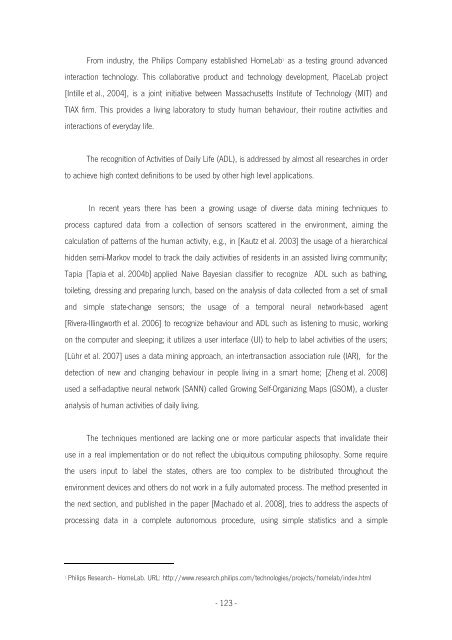Carlos Manuel Rodrigues Machado Autonomic Ubiquitous Computing
Carlos Manuel Rodrigues Machado Autonomic Ubiquitous Computing
Carlos Manuel Rodrigues Machado Autonomic Ubiquitous Computing
Erfolgreiche ePaper selbst erstellen
Machen Sie aus Ihren PDF Publikationen ein blätterbares Flipbook mit unserer einzigartigen Google optimierten e-Paper Software.
From industry, the Philips Company established HomeLab 1 as a testing ground advanced<br />
interaction technology. This collaborative product and technology development, PlaceLab project<br />
[Intille et al., 2004], is a joint initiative between Massachusetts Institute of Technology (MIT) and<br />
TIAX firm. This provides a living laboratory to study human behaviour, their routine activities and<br />
interactions of everyday life.<br />
The recognition of Activities of Daily Life (ADL), is addressed by almost all researches in order<br />
to achieve high context definitions to be used by other high level applications.<br />
In recent years there has been a growing usage of diverse data mining techniques to<br />
process captured data from a collection of sensors scattered in the environment, aiming the<br />
calculation of patterns of the human activity, e.g., in [Kautz et al. 2003] the usage of a hierarchical<br />
hidden semi-Markov model to track the daily activities of residents in an assisted living community;<br />
Tapia [Tapia et al. 2004b] applied Naive Bayesian classifier to recognize ADL such as bathing,<br />
toileting, dressing and preparing lunch, based on the analysis of data collected from a set of small<br />
and simple state-change sensors; the usage of a temporal neural network-based agent<br />
[Rivera-Illingworth et al. 2006] to recognize behaviour and ADL such as listening to music, working<br />
on the computer and sleeping; it utilizes a user interface (UI) to help to label activities of the users;<br />
[Lühr et al. 2007] uses a data mining approach, an intertransaction association rule (IAR), for the<br />
detection of new and changing behaviour in people living in a smart home; [Zheng et al. 2008]<br />
used a self-adaptive neural network (SANN) called Growing Self-Organizing Maps (GSOM), a cluster<br />
analysis of human activities of daily living.<br />
The techniques mentioned are lacking one or more particular aspects that invalidate their<br />
use in a real implementation or do not reflect the ubiquitous computing philosophy. Some require<br />
the users input to label the states, others are too complex to be distributed throughout the<br />
environment devices and others do not work in a fully automated process. The method presented in<br />
the next section, and published in the paper [<strong>Machado</strong> et al. 2008], tries to address the aspects of<br />
processing data in a complete autonomous procedure, using simple statistics and a simple<br />
1 Philips Research– HomeLab. URL: http://www.research.philips.com/technologies/projects/homelab/index.html<br />
- 123 -

















